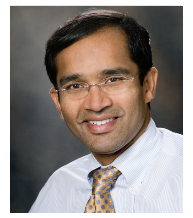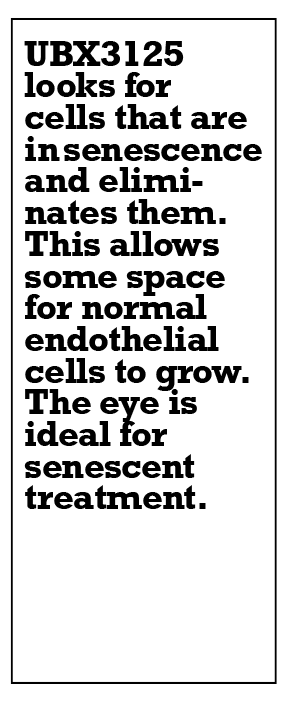| By Richard Mark Kirkner, Editor |
 |
| With Raj K. Maturi, MD |
 |
UBX1325, a small-molecule B-cell inhibitor under investigation for treatment of neovascular age-related macular degeneration and diabetic macular edema, is the vanguard of medical therapies that target senescent cells. Senescence is defined as “the state of being old; the process of becoming old.”
UBX1325 aims to inhibit Bcl-xL, one of the Bcl-2 family of apoptosis-regulating proteins that senescent cells need for survival. Raj K. Maturi, MD, of Midwest Eye Institute in Indianapolis and a clinical associate professor at the University of Indiana School of Medicine, and a UBX1325 investigator, describes senolytic therapy as “an entirely new paradigm of treatment.” He adds, “Unlike other things that we do, where we try to do our best to preserve cells, the UBX paradigm is entirely the opposite.”
The idea is to disrupt the proteins that senescent cells feed on for survival. Dr. Maturi reported 24-week Phase I results in people with chronic AMD and DME at the American Society of Retina Specialists’ 40th annual scientific meeting.1 Later, trial sponsor Unity Biotechnology reported 12- and 18-week outcomes from a Phase II trial in DME, which showed that treated patients gained +6.1 letters of vision after 18 weeks while maintaining central subfield thickness.2
Here, Dr. Maturi answers questions about UBX 1325. Dr. Maturi also serves on Unity Biotechnology’s scientific advisory board.
Q: What’s the principle behind senolytic therapy?
A: Inflammation or any other damage to a tissue or cell causes the most-affected cells to go into senescence. Typically, they stop dividing, a process that applies mostly to vascular tissue.
These damaged cells then excrete senescent factors, such as cytokines, inflammatory mediators and fibroblast attractors, all of which cause inflammation. UBX1325 aims to prevent production of these chemokines and other factors. Where steroids and other drugs inhibit them, the thinking is to eliminate this layer of senescent cells.
 |
Q: How would you describe the mechanism of action of UBX3125?
A: UBX3125 looks for cells that are in senescence and eliminates them. This allows some space for normal endothelial cells to grow. That’s the beauty of senescent treatment. The eye is ideal for it because, obviously, it’s sequestered to this one tissue where we can make sure the effect is very local.
Q: How did the preclinical research inform the in-human studies?
A: First, researchers had to answer the question: Is there an increase in senescent cells in patients with AMD and diabetes? The answer is, yes; much more so than in healthy older people.
The second question was: Can we make sure senescent treatment with UBX doesn’t harm any normal tissue? Testing in an oxygen-induced retinopathy mouse model, for diabetic retinopathy and leukemia, found that UBX, like anti-VEGF, doesn’t cause new blood vessel growth.
But there was one big difference. With anti-VEGF treatments, the area of ischemic tissue is fairly large. The UBX-treated mice model showed a smaller area of ischemic tissue because abnormal endothelial cells were completely killed, which actually allowed more normal tissue to grow over the time.
Q: What are the key messages from the 24-week Phase I trial?
A: This was a standard dose-escalation study of low to medium to high doses in patients who continued to have edema with AMD and DME. (Dosing was at 0.5, 1.5, 5 and 10 μg.) Data were analyzed for each group separately.
There were no safety issues, no issues of inflammation and there were no significant dropouts. Both groups showed a significant increase in vision within the first two weeks. The diabetic patients (n=8) showed an almost 10-letter gain in vision, much of which lasted through 24 weeks without any additional treatments. Just a couple patients in the diabetes arm needed rescue, but these patients had that observation carried forward so their visual gain after rescue was not recorded. There was some nice vision gain in these patients. (At Week 24, 62.5 percent of DME patients gained ≥5 letters and 50 percent gained ≥10 letters.)
Optical coherence tomography improved initially, but then it came back to baseline somewhat after a few weeks. (Overall, central subfield thickness remained stable through 24 weeks in most DME patients.)
Q: What were the results in the AMD patients?
A: The results weren’t as robust as in DME. The AMD patients (n=10) had a 5-letter gain on average in first two to three weeks of treatment. They maintained this vision gain throughout with more patients requiring rescue treatments than the DME group.
The biggest key takeaway is that we found that UBX1325 is actually relatively safe in the eye. The second key takeaway is that it actually had a biologic effect. There was improvement in vision in diabetes patients as well as the AMD patients, and some of the effect can be relatively long-lasting, especially in the diabetes populations.
Q: What are the next steps in development of UBX1325?
A: Because of the Phase I data, two Phase II studies have been started: one in DME using the highest dose from the Phase I study, 10 μg; and another in AMD in which patients could be given two doses about eight weeks apart. In the Phase I study, AMD patients needed more rescue and the concept here is that UBX could potentially decrease anti-VEGF dosing. Given what we learn from these studies, UBX may have some role in other ischemic diseases. RS
REFERENCES
1. Maturi R, Klier S, Salelhi-Had H, Dannanberg J. UBX1325, A novel senolytic therapy for treatment-experienced patients with chronic DME or wet AMD: 24-week results of a Phase 1 study. Paper presented at the American Society of Retina Specialists annual meeting; July 14, 2022; New York, NY.
2. Unity Biotechnology announces positive data in Phase 2 behold study of UBX1325 in patients with diabetic macular edema [news release]. South San Francisco, CA: Unity Biotechnology; August 12, 2022. https://ir.unitybiotechnology.com/news-releases/news-release-details/unity-biotechnology-announces-positive-data-phase-2-behold-study Accessed August 31, 2022.



